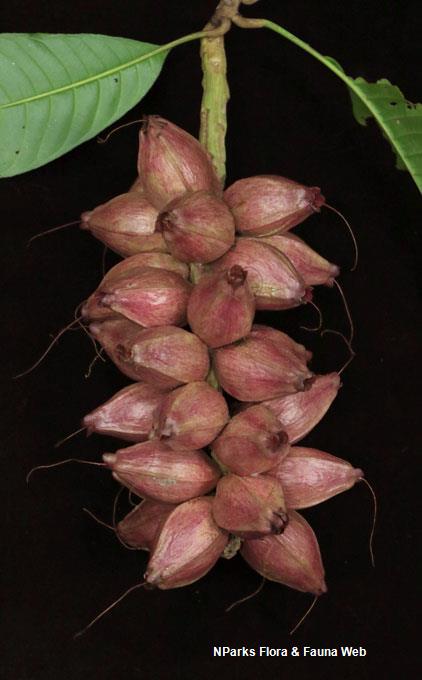_lowres.jpg)
Back
Barringtonia calyptrata (Miers) R. Br. ex Bailey
| Family Name: | Lecythidaceae |
| Common Name: | Corned Beef Wood, Mango Pine, Cassowary Pine, Tufan |
Barringtonia calyptrata produces wood that smell like corned-beef, giving it the common name Corned Beef Wood. Flower stalks hang pendulously on the tree branches and are densely covered with up to 60 white flowers each.
Name
Classifications and Characteristics
| Plant Division | Angiosperms (Flowering Seed Plants) |
|---|---|
| Plant Growth Form | Tree |
| Mode of Nutrition | Autotrophic |
| Maximum Height | 20 m |
Biogeography
| Native Distribution | From Indonesia, New Guinea to Northern Australia |
|---|---|
| Native Habitat | Terrestrial |
| Preferred Climate Zone | Tropical |
| Local Conservation Status | Non-native |
Description and Ethnobotany
| Growth Form | It is a tree, up to 20 m tall. Growth is episodic and characterised by a series of scale-like leaves (cataphylls), which is triangular, 2 – 5 mm long and 2 mm wide. |
|---|---|
| Foliage | Leaves are leathery, obovate to oblong (10 – 29 cm long and 4 – 13 cm wide) and tend to cluster at the tip of the branches. The leaf tip is obtuse or rarely has a long tip, while the leaf base is cuneate and decurrent almost to the petiole base. The leaf margin is entire. 8 – 20 pairs of lateral veins are present and intercostal veins are slightly raised on both surfaces. The petiole is 0.5 – 3 cm long and slightly swollen at the base. |
| Flowers | Inflorescence hangs pendulously on the branches (ramiflorous), about 30 – 40 cm long. Each flowering stalk is densely covered with up to 60 flowers. The flower is sessile with grooved grey-green hypanthium (3 – 4 mm long and 3 – 4 mm wide). Flower comprises of 4 – 5 small red or white petals (1.25 – 2.5 cm long and 0.5 – 1.75 cm wide), and numerous white stamens arranged in whorls of 4 – 5 (-7). Style is 3 – 4.5 cm long, white, and persists in fruit. |
| Fruit | Fruit is ovoid or spindle-shaped (5 – 9.5 cm long, 1.75 – 2.5 cm wide) that tapers at both ends. Each fruit contains one subglobular seed within, that is about 2 cm long and 1.5 cm wide. |
| Habitat | It is found in open savannah, along streams and rivers, and rarely in mangrove forest. |
| Associated Fauna | In Northern Australia, Cassowaries are observed to disperse the seeds. |
| Etymology | The genus Barringtonia commemorates Daines Barrington (1727 – 1800), a British naturalist. Specific epithet calyptrate means hooded or covered, referring to the flower buds. |
| Ethnobotanical Uses | Timber & Products: The wood is soft and said to smell like corned-beef. The wood has an even grain pattern and is used for general purpose such as flooring. Others: In New Guinea, boiled leaves are used by indigenous people to treat chest pain. |
Landscaping Features
| Desirable Plant Features | Ornamental Flowers |
|---|
Plant Care and Propagation
| Light Preference | Full Sun |
|---|---|
| Water Preference | Moderate Water |
| Plant Growth Rate | Moderate |
Foliar
| Mature Foliage Colour(s) | Green |
|---|---|
| Leaf Area Index (LAI) for Green Plot Ratio | 3.0 (Tree - Intermediate Canopy) |
Floral (Angiosperm)
| Flower Colour(s) | White |
|---|
References
| References | Prance, G.T. (2012). A Revision of Barringtonia (Lecythidaceae). Allertonia 12: 1–161. Prance, G.T. & Kartawinata, E.K. (2013). Lecythidaceae. In: Nooteboom, H.P. & van Welzen, P.C. (ed.) Flora Malesiana, ser. 1, vol. 21, pp. 1–118. Leiden: Naturalis Biodiversity Center. |
|---|
Image Repository
Others
| Master ID | 1452 |
|---|---|
| Species ID | 2745 |
| Flora Disclaimer | The information in this website has been compiled from reliable sources, such as reference works on medicinal plants. It is not a substitute for medical advice or treatment and NParks does not purport to provide any medical advice. Readers should always consult his/her physician before using or consuming a plant for medicinal purposes. |

_lowres.jpg)
_lowres.jpg)
_lowres.jpg)
_lowres.jpg)

_lowres.jpg)
_lowres.jpg)


_lowres.jpg)
